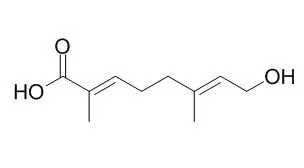| In vitro: |
| Phytother.Res.,2016 Oct;30(10):1624-33. | | Phytochemical and Pharmacological Investigations on Nymphoides indica Leaf Extracts.[Pubmed: 27282639 ] | Nymphoides indica (L.) Kuntze (Menyanthaceae) is traditionally used in the Indian subcontinent. However, scientific data reporting its constituents are poor. This study aimed at evaluating its phytochemical constituents and various biological activities.
METHODS AND RESULTS:
Phytochemical investigations of the extracts and fractions resulted in the isolation of 5 lipophilic compounds, i.e. azelaic (nonanedioic) acid (1) and 4-methyl-heptanedioic acid (3), hexadecanoic (2) and stearic acid (5) and the fatty alcohol hexadecanol (4); 3 seco-iridoids, i.e. 7-epiexaltoside (6), 6″,7″-dihydro-7-epiexaltoside (7) and menthiafolin (8); 3 flavonoids, i.e. 3,7-di-O-methylquercetin-4'-O-β-glucoside (9), 3-O-methylquercetin-7-O-β-glucoside (10) and 3,7-di-O-methylquercetin (11); scopoletin (12) and ferulic acid (13); and the monoterpenoids Foliamenthoic acid (14) and 6,7-dihydroFoliamenthoic acid methyl ester (15). Compounds 1-5 showed moderate antimicrobial activities, whereas compound 9 presented mild antiprotozoal activities against Trypanosoma brucei (IC50 8 μM), Leishmania infantum (IC50 32 μM) and Trypanosoma cruzi (IC50 30 μM). Antiglycation activity was shown by compounds 7 (IC50 0.36 mM), 10 (IC50 0.42 mM) and 15 (IC50 0.61 mM). Finally α-glucosidase inhibition was shown by compounds 7, 9, 11 and 13-15.
CONCLUSIONS:
It could be concluded that N. indica leaf extracts possess mild to moderate antimicrobial, antiprotozoal, antioxidant and antidiabetic activities. |
|






 Cell. 2018 Jan 11;172(1-2):249-261.e12. doi: 10.1016/j.cell.2017.12.019.IF=36.216(2019)
Cell. 2018 Jan 11;172(1-2):249-261.e12. doi: 10.1016/j.cell.2017.12.019.IF=36.216(2019) Cell Metab. 2020 Mar 3;31(3):534-548.e5. doi: 10.1016/j.cmet.2020.01.002.IF=22.415(2019)
Cell Metab. 2020 Mar 3;31(3):534-548.e5. doi: 10.1016/j.cmet.2020.01.002.IF=22.415(2019) Mol Cell. 2017 Nov 16;68(4):673-685.e6. doi: 10.1016/j.molcel.2017.10.022.IF=14.548(2019)
Mol Cell. 2017 Nov 16;68(4):673-685.e6. doi: 10.1016/j.molcel.2017.10.022.IF=14.548(2019)